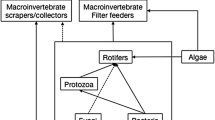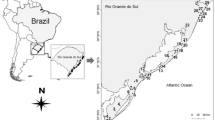Abstract
This study examined patterns of faunal stratification between vertical strata by partitioning subtidal macroalgal communities into vertically contiguous (and hence paired) canopy and understorey habitats. Such floristic strata are often clearly defined in temperate subtidal communities and have been the focus of a range of other, primarily botanical, studies. Previous studies that have touched upon this subject have used statistical tests that require spatially independent samples, yet have collected samples that are often spatially contiguous and therefore not statistically independent. Here an analytical approach for examining faunal stratification in subtidal macroalgal assemblages using split-plot ANOVA for univariate data and a novel multivariate test suitable for analysing assemblage-level paired-sampled data is proposed. Differences in faunal assemblage structure between habitats were primarily attributed to the distribution of two functional feeding groups: filter-feeding and scavenging arthropods. Filter-feeders were more abundant amongst the canopy, whereas scavengers were more abundant in the understorey. No pattern was detected for herbivorous arthropods. These patterns are consistent with the feeding ecology of these functional groups and reflect expected differences in the relative availability of trophic resources between habitats, commensurate with the physical structure of the environments. Contrary to expectation, understorey algal habitats supported faunal assemblages that were as diverse, or more diverse than the canopy habitats, despite comprising smaller habitable spaces (in terms of algal biomass) and generally supporting fewer faunal individuals. Trophic stratification of epifaunal assemblages is suggested as a mechanism whereby faunal diversity is enhanced in these environments.






Similar content being viewed by others
References
Barnard JL (1972) Gammaridean amphipoda of Australia, Part 1. Smithson Contrib Zoo 103:1–333
Barnard JL (1974) Gammaridean Amphipoda of Australia, Part 2. Smithson Contrib Zoo 139:1–148
Barnard JL, Thomas JD, Sandved KB (1988) Behaviour of gammaridean amphipoda: Corophium, Grandidierella, Podocerus and Gibberosus (American Megaluropus) in Florida. Crustac Suppl 13:234–244
Basset Y (2001) Communities of insect herbivores foraging on sapling versus mature trees of Pourouma bicolor (Cecropiaceae) in Panama. Oecologia 129:253–260
Basset Y, Novotny V, Miller SE, Kitching RL (2003) Vertical stratification of arthropod assemblages. In: Basset Y, Novotny V, Miller SE, Kitching RL (eds) Arthropods of tropical forests: spatial-temporal dynamics and resource use in the canopy. Cambridge University Press, Cambridge, pp 17–27
Bruce PC (1993) Resampling Stats. Version 3.14. Resampling Stats Inc, Arlington
Caine EA (1977) Feeding mechanisms and possible resource partitioning of the Caprellidae (Crustacea: Amphipoda) from Puget Sound, USA. Mar Biol 42:331–336
Chemello R, Milazzo M (2002) Effect of algal architecture on associated fauna: some evidence from phytal molluscs. Mar Biol 140:981–990
Christie H, Jorgensen NM, Norderhaug KM, Waage-Nielsen E (2003) Species distribution and habitat exploitation of fauna associated with kelp (Laminaria hyperborea) along the Norwegian coast. J Mar Biol Ass UK 83:687–699
Clarke KR (1993) Non-parametric multivariate analyses of changes in community structure. Aust J Ecol 18:117–143
Clarke KR, Warwick RM (2001) Change in marine communities: an approach to statistical analysis and interpretation, 2nd edn. PRIMER-E, Plymouth
Collings GJ, Cheshire AC (1998) Composition of subtidal macroalgal communities of the lower gulf waters of South Australia, with reference to water movement and geographical separation. Aust J Bot 46:657–669
Colwell RK (1997) EstimateS: statistical estimation of species richness and shared species from samples. Version 5.0.1. University of Connecticut, Storrs
Colwell RK, Coddington JA (1994) Estimating terrestrial biodiversity through extrapolation. Philos Trans R Soc Lond B 345:101–118
Connell SD (2003) Negative effects overpower the positive of kelp to exclude inverterbrates from the understorey community. Oecologia 137:97–103
Cruz-Rivera E, Hay ME (2001) Macroalgal traits and the feeding and fitness of an herbivorous amphipod: the roles of selectivity, mixing and compensation. Mar Ecol Prog Ser 218:249–266
Duggins DO, Eckman JE (1994) The role of kelp detritus in the growth of benthic suspension feeders in an understorey kelp forest. J Exp Mar Biol Ecol 176:53–68
Duggins DO, Eckman JE, Sewell AT (1990) Ecology of understorey kelp environments. II. Effects of kelps on recruitment of benthic invertebrates. J Exp Mar Biol Ecol 143:27–45
Eckman JE, Duggins DO (1991) Life and death beneath macrophyte canopies: effects of understorey kelps on growth and survival of marine, benthic suspension feeders. Oecologia 87:473–487
Eckman JE, Duggins DO, Sewell AT (1989) Ecology of understorey kelp environments I. Effects of kelps on flow and particle transport near the bottom. J Exp Mar Biol Ecol 129:173–187
Edgar GJ (1983a) The ecology of south-east Tasmanian phytal animal communities. I. Spatial organisation on a local scale. J Exp Mar Biol Ecol 70:129–157
Edgar GJ (1983b) The ecology of south-east Tasmanian phytal animal communities. III. Patterns of species diversity. J Exp Mar Biol Ecol 70:181–203
Edgar GJ (2001) Australian marine habitats in temperate waters. New Holland Publishers, Sydney
Edgar GJ, Klumpp DW (2003) Consistencies over regional scales in assemblages of mobile epifauna associated with natural and artificial plants of different shape. Aquat Bot 75:275–291
Foggo A, Attrill MJ, Frost MT, Rowden AA (2003) Estimating marine species richness: an evaluation of six extrapolative techniques. Mar Ecol Prog Ser 248:15–26
Fowler-Walker MJ, Connell SD (2002) Opposing states of subtidal habitat across temperate Australia: consistency and predictability in kelp canopy-benthic associations. Mar Ecol Prog Ser 240:49–56
Goodsell PJ, Fowler-Walker MJ, Gillanders BM, Connell SD (2004) Variations in the configuration of algae in subtidal forests: Implications for invertebrate assemblages. Aust Ecol 29:350–357
Gotelli NJ, Graves GR (1996) Null models in ecology. Smithsonian Institution, Washington
Hacker SD, Steneck SS (1990) Habitat architecture and the abundance and body-size-dependent habitat selection of a phytal amphipod. Ecology 71:2269–2285
Hay ME (1991) Marine-terrestrial contrasts in the ecology of plant chemical defences against herbivores. TREE 6:362–364
Hirst AJ (2004) Biodiversity of arthropod epifauna associated with subtidal macroalgal communities: effects of algal species richness and composition on faunal assemblage structure. PhD Thesis, Flinders University, Adelaide, Australia
Irving AD, Connell SD, Gillanders BM (2004) Local complexity in patterns of canopy-benthos associations produces regional patterns across temperate Australia. Mar Biol 144:361–368
Kennelly SJ (1987) Physical disturbances in an Australian kelp community. II. Effects on understorey species due to differences in kelp cover. Mar Ecol Prog Ser 40:155–165
Kennelly SJ (1989) Effects of kelp canopies on understorey species due to shade and scour. Mar Ecol Prog Ser 50:215–224
Manly BFJ (1997) Randomisation, Bootstrap and Monte Carlo methods in biology. Chapman and Hall, London
Norderhaug KM, Christie H, Rinde E (2002) Colonisation of kelp imitations by epiphyte and holdfast fauna; a study of mobility patterns. Mar Biol 141:965–973
Novotny V, Basset Y, Kitching RL (2003) Herbivore assemblages and their food resources. In: Basset Y, Novotny V, Miller SE, Kitching RL (eds) Arthropods of tropical forests: spatio-temporal dynamics and resource use in the canopy. Cambridge University Press, Cambridge, pp 40–53
Poore AGB, Steinberg PD (1999) Preference-performance relationships and effects of host plant choice in an herbivorous marine amphipod. Ecol Monogr 69:443–464
Poore AGB, Watson MJ, de Nys R, Lowry JK, Steinberg PD (2000) Patterns of host use among alga- and sponge-associated amphipods. Mar Ecol Prog Ser 208:183–196
Russo AR (1990) The role of seaweed complexity in structuring Hawaiian epiphtyal amphipod communities. Hydrobiologia 194:1–12
Schiel DR (1994) Kelp communities. In: Hammond LS, Synnot RN (eds) Marine biology Longman Cheshire, Melbourne, pp 345–361
Schulze CH, Linsenmair KE, Fieldler K (2001) Understorey versus canopy: vertical stratification and diversity among Lepidoptera in a Bornean rain forest. Plant Ecol 153:133–152
Shepherd SA, Womersley HB (1981) The algal and seagrass ecology of Waterloo Bay, South Australia. Aquat Bot 11:305–371
Smith SDA, Simpson RD (1995) Effects of the ‘Nella Dan’ oil spill on the fauna of Durvillaea antarctica holdfasts. Mar Ecol Prog Ser 121:73–89
Steinberg PD, Kendrick GA (1999) Kelp forests. In: Andrew N (ed) Under Southern Seas. The ecology of Australia’s rocky reefs. UNSW Press, Sydney, pp 61–71
Steneck SS, Dethier MN (1994) A functional group approach to the structure of algal-dominated communities. Oikos 69:476–498
Taylor RB, Cole RG (1994) Mobile epifauna on subtidal brown seaweeds in northeastern New Zealand. Mar Ecol Prog Ser 115:271–282
Thiel M (2000) Population and reproductive biology of two sibling amphipod species from ascidians and sponges. Mar Biol 137:661–674
Toohey B, Kendrick G, A, Wernberg T, Phillips JC, Malkin S, Prince J (2004) The effects of light and thallus scour from Ecklonia radiata on an associated foliose algal assemblage: the importance of photoacclimation. Mar Biol 144:1019–1027
Ugland KI, Gray JS (2004) Estimation of species richness: analysis of the methods developed by Chao and Karakassis. Mar Ecol Prog Ser 284:1–8
Womersley HBS (1984) The marine benthic flora of Southern Australia Part I. Government Printer, South Australia, Adelaide
Womersley HBS (1987) The marine benthic flora of Southern Australia Part II. Government Printer, South Australia, Adelaide
Zar JH (1996) Biostatistical analysis, 3rd edn. Prentice-Hall Inc, Upper Saddle River, New Jersey
Acknowledgments
I thank Daryl Metters for considerable help in the field and the Marine Biology Section of Museum Victoria for loan of the air-lift sampler. I would also like to thank G. Poore, R. Peart and D. Staples for help with identification of the invertebrate fauna and B. Baldock and S. Shepherd for help with identification of macroalgae. This manuscript benefited from discussion with and comments from P. Fairweather, S. Smith and three anonymous reviewers. The work was undertaken as part of a Doctor of Philosophy degree at Flinders University, Adelaide and was supported by a Flinders University Postgraduate Scholarship.
Author information
Authors and Affiliations
Corresponding author
Additional information
Communicated by M. S. Johnson, Crawley
Rights and permissions
About this article
Cite this article
Hirst, A.J. Vertical stratification of mobile epiphytal arthropod assemblages between the canopy and understorey of subtidal macroalgae. Mar Biol 150, 427–441 (2007). https://doi.org/10.1007/s00227-006-0345-x
Received:
Accepted:
Published:
Issue Date:
DOI: https://doi.org/10.1007/s00227-006-0345-x




